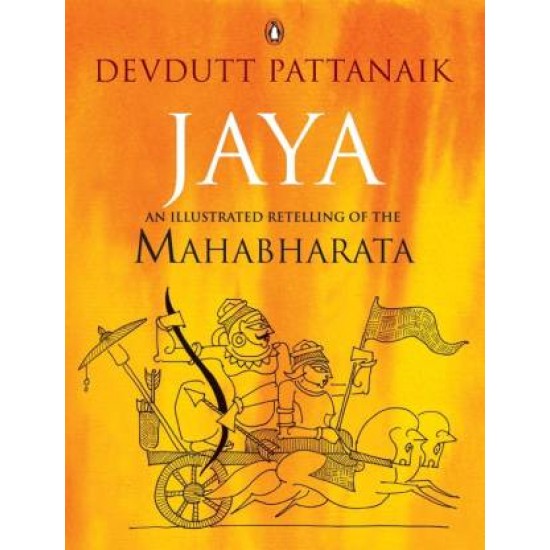
The Mahabharata, India's greatest epic, is a huge, sweeping work and is the longest Sanskrit epic. It tells the story of the Kuru family, and the events that lead to the fratricidal Mahabharata War. It describes the events during the 18-day war and its aftermath.
In the Jaya: An Illustrated Retelling of the Mahabharata, Devdutt Pattanaik has condensed the epic into a small capsule. For those who do not know the story of the Mahabharata, this can be a good choice for a first book based on Mahabharata. What makes this book special is that it collects tales from various regional and folk versions in addition to the original Sanskrit composition. This book is divided into 108 chapters and is illustrated with around 250 simple line drawings done by the author himself.
The author draws the reader into an interesting retelling of the Mahabharata. The book contains many intriguing tales from other versions of the epic, not just the major regional versions, but also those used in enacting the epic in folk arts like Chattisgarh's Pandavani, Tamil Nadu's Terukuttu and Karnataka's Yakshagana.
The book contains stories of Aravan, Barbareek, Jaimini, Astika and Madhavi. It also highlights some intriguing traditions like the Draupadi temples in Tamilnadu where she is worshipped as a Goddess. It devotes pages to the Mahabharata versions of Sanskrit Classics like Shakuntalam and Ramayana.
The author also devotes a section to dating the Mahabharata War based on the detailed astronomical information provided in the book, like the position of certain constellations etc. By bringing together many prevalent versions of the Mahabharata, he gives a pan-Indian view of the epic that has shaped the history and culture of the country over millennia.
General Reception
The book has become a popular choice for those who want to read the story of the epic for the first time as well as those who want to know even more about the Mahabharata and its sweeping influence on the country's culture and traditions. This highlight of the book is its simple style and the author's own interpretations of various incidents in the epic.
About the Author
Devdutt Pattanaik is a doctor who shifted his focus to Indian mythology and their influence on the people of the country. He has written many books based on Indian epics and Puranas.
Devdutt Pattanaik has written other books based on Hindu epics and other related works. Some of his other books are:
- Devi, the Mother-Goddess: an introduction
- Shiva: an introduction
- Vishnu: an introduction
- The Goddess in India: the five faces of the eternal feminine
- Hanuman: an introduction
- The Man Who Was A Woman and other queer tales of Hindu lore
- Lakshmi, the goddess of wealth and fortune: an introduction
His Writing Style
Devdutt Pattanaik's style is simple and elegant, and he adds value by creating his own line drawing illustrations ? an unusual combination. He is not strictly traditional in his retelling, yet he remains true to the original spirit of the stories. He also explores the influence of the epics on Indian thought and their continued relevance to life, even today, thousands of years after the stories were written.
His Personal Life
Devdutt Pattanaik grew up in Mumbai and graduated with a degree in medicine from the Grant Medical College. He later studied Comparative Mythology at Mumbai University.
After working in the Healthcare industry for 14 years, he turned his attention to the wisdom and insights contained in the ancient Hindu texts. He started to write books and columns on the subject and has also delivered many lectures on Indian mythology.
| Books Information | |
| Author Name | Devdutt Pattanaik |
| Condition of Book | Used |
- Stock: Out Of Stock
- Model: sga1494

















